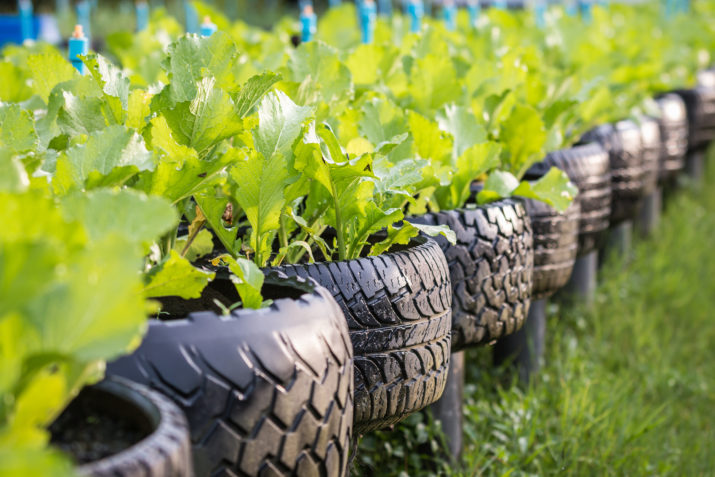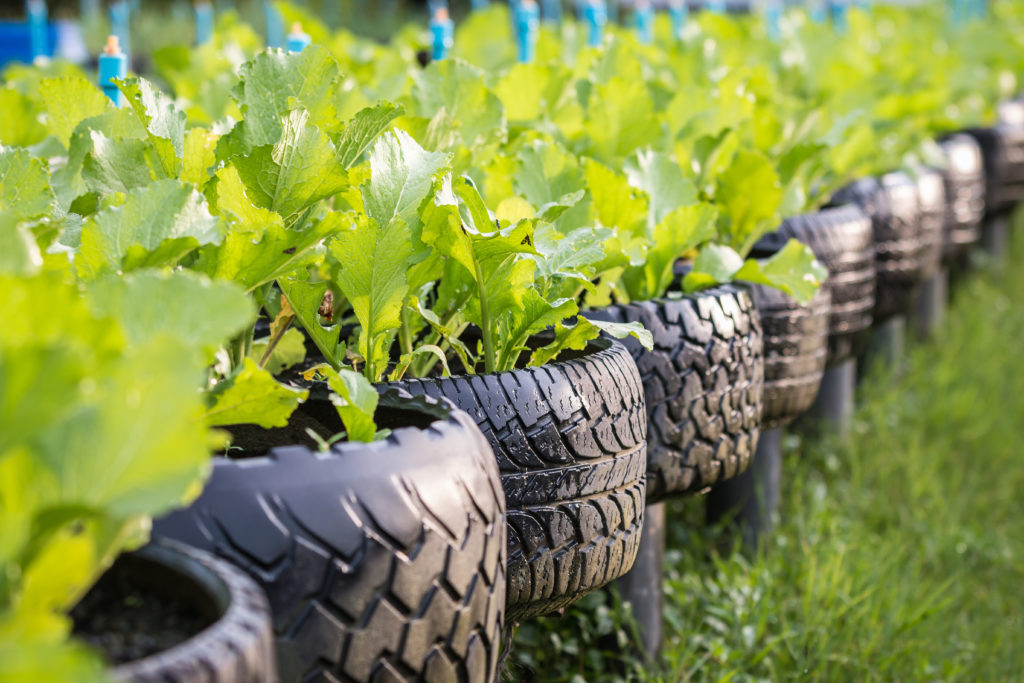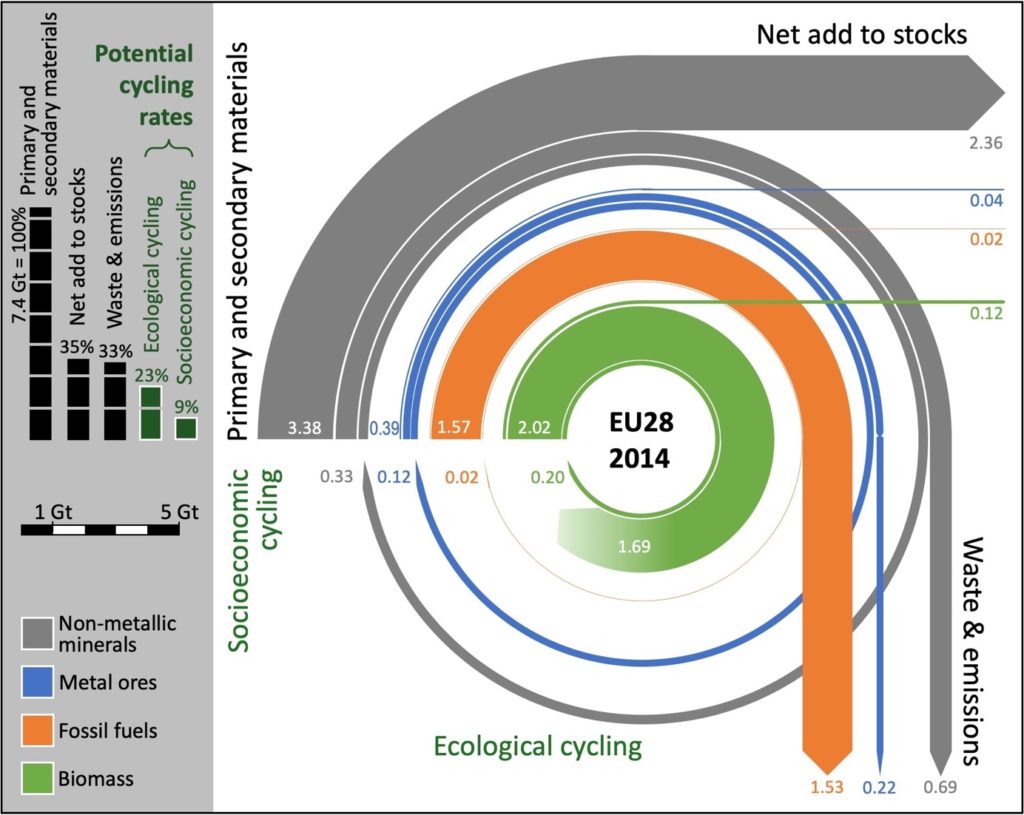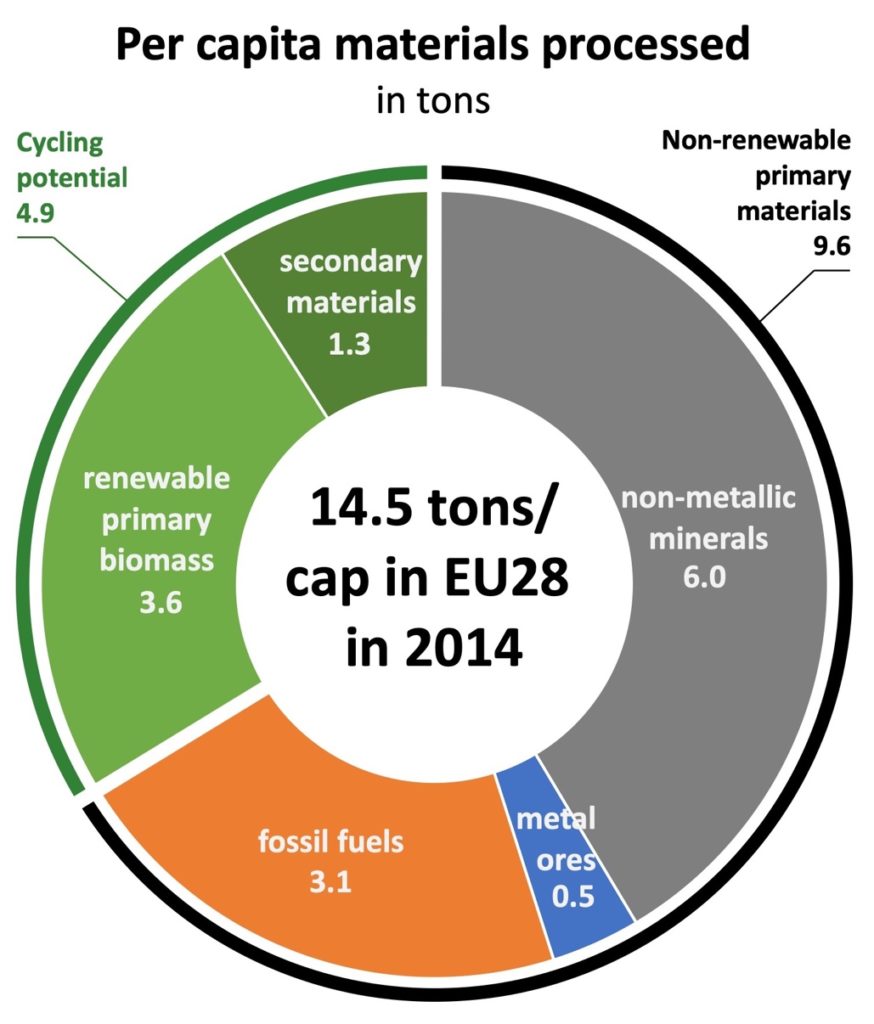

This is part of our special feature, Confronting Waste.
Biophysical growth as modus operandi of our societies
When I visit my childhood neighborhood, I hardly recognize it. Empty spaces have been filled; what was once, in the seventies, a one-storied building, is now multileveled. Even a sky-scrapper has risen. In addition to a train line there is now an underground system, and the small road with unsurfaced shoulders has been replaced with a four-lane freeway, with pedestrian paths on both sides. Each flat has more floor space per person, a bigger TV, new electronic devices, a dishwasher, a microwave, and more. Increasingly, people have cars, and those are mostly bigger. While population growth in my home country of Austria has been modest, almost everything else has grown and there is hardly any area where number and size of artefacts have been shrinking. Austria is not alone. After a steep growth in recent years, Europe’s material footprint (EU28) is at an all-time high, especially when considering global material flows that are triggered by European final consumption (Wiedmann et al. 2015).
The past of my childhood neighborhood shows an enormous growth in societal stocks like buildings, roads or cars. When studying the biophysical dimensions of economies in later years, I began to realize that these growing societal stocks enshrine future material and energy flows for maintenance and operation for years to decades, if not centuries, since they last long, shape lifestyles, and create persistent structures for future goods and services (Krausmann et al. 2017). This is an issue of utmost importance for any societal transformation, and requires delving deeper into the characteristics of Europe’s biophysical economy, its state, and potential for circularity.
Resource use is overshooting the limits for a safe operating space of humanity
Europe’s biophysical economy extracted 5.8 Gt (billion tons) of material from nature, imported 1.5 Gt from other economies, and exported 0.6 Gt. This results in a domestic material consumption of 6.7 Gt (extraction plus imports minus exports) (Mayer et al. 2018). These numbers are hardly conceivable. Per capita data show that domestic material consumption per European resident per year is about 13 tons/cap, with Spain being at the lower end (9 tons/cap) and Finland at the upper end (31 tons/cap) (Eurostat). Societal stocks per capita amount to roughly 300 tons/cap in Europe (Bergsdal et al. 2007; Daxbeck et al. 2009; Müller 2006; Rubli et al. 2005) and 115 tons/cap globally (Krausmann et al. 2017). Statistics on societal stocks hardly exist. Thus, only studies with modeled results and often only for specific countries, stocks (e.g. buildings) or material categories (e.g. metals) are available.
In a world where trade materially interlinks economies, Europe does more than simply cause material flows within its borders. The so-called emerging countries are often called the extended workbench for industrialized regions like Europe. Europe’s biophysical economy needs to be understood within the interconnected global economy of which it is part. In recent decades, global extraction of materials has rocketed, with growth rates in the same range as post-World War II, a period called “the great acceleration” (Steffen et al. 2016). Along with extraction, waste and emissions are rapidly increasing as well, at an annual rate of 3 percent between 2002 and 2015 (Krausmann et al. 2018). While post-World War II growth already caused serious environmental problems, mostly at the local level, today’s growth and resulting material and energy flows are overshooting the planetary boundaries of a safe operating space for humanity (Steffen et al. 2015). Biochemical flows of nitrogen and phosphorus, biodiversity and climate change are all symptoms of the resource hunger of affluent societies like Europe. To stay within planetary boundaries in a just world, where some countries have not had their share of material wealth yet, a stabilization of resource use in Europe is not sufficient. A drastic reduction is needed (Fischer-Kowalski et al. 2013; Krausmann et al. 2018; UNEP 2011).
Counteracting increasing resource flows: circular economy
The circular economy comes into play as a simple and fascinating idea: What if we materially and energetically fed our economies only from renewable sources and cycle non-renewable resources as long as possible within the economy, resulting in high lifetimes for all products and infrastructures and thus minimizing non-renewable inputs? (Haas et al. 2015). We would preserve our standards of living at the same levels while using only a fraction of primary resources compared to what we use today. Strategies range from recycling to eco-design aiming at using long-lasting, repairable, energy-saving and recyclable products. It would turn goods discarded by some into resources for others, close material loops in industrial systems, and minimize waste. As an idea that promises jobs for repair, remanufacturing, and recycling, it also would offer opportunities for innovative business in a sharing or service economy, where manufacturers for example do not sell cars or washing machines, but they sell services like personal mobility or clean clothes. Thus, manufacturers would retain ownership of cars or washing machines and their embodied resources, pay for operational costs and carry the responsibility for risks of failure and waste. Consequently, they would opt for long-lasting equipment and reliable provision of services at highest energy-saving standards. Professional management of collection and delivery could even decrease the number of cars or washing machines. At the end of the lifetime of service-provisioning products, components could be reused or material recycled for new products. Since fossil fuels are non-renewable resources and their combustion does not allow for closing loops, there is no place in a circular economy for them. However, other renewable energy sources like wind, hydro or solar power could replace them, and, if power plants were eco-designed, they would fit perfectly into a circular economy. Biomass itself, a potentially renewable resource, could be used for food and animal feed as well as for biodegradable packaging or other short-lived products. Altogether, it seems like a rewarding future for which all should strive.
Like China and Japan, Europe has launched initiatives to boost circularity (Geissdoerfer et al. 2017). An action plan promotes a systemic approach across entire value chains targeting plastic production and consumption, water management, food systems, and the management of specific waste streams. Associated with the action plan, a revised waste legislation requires that by 2030, 70 percent of all packaging waste should be recycled, and by 2035, 65 percent of municipal waste should be recycled, all the while reducing landfilling of municipal waste to 10 percent. To accelerate the transition, more research and eco-innovative technologies are supported by European Union public funding (European Commission 2019).
Critically assessing the circular economy requires a system perspective
The physical economy is as complex as the monetary one. Reviewing the state of circularity requires conceptual clarity. Monetary systems are analyzed via national accounts, which can be combined with a world region or the entire world. The material flow accounting framework is also based on country levels, and follows the same principles for four material categories as they are extracted from nature or imported from other countries: biomass, metal ores, non-metallic minerals and fossil fuels (Eurostat 2013; Fischer-Kowalski et al. 2011; Haas et al. 2015; Mayer et al. 2018). EUROSTAT publishes these data regularly. The systemic and cross-scale perspective is important, since in an interconnected world it needs to be understood whether circular economy strategies drastically reduce resource flows and their environmental pressures or just shift flows and problems to other world regions where they continue to overshoot the planetary boundaries for a safe operating space of humanity.
An example of externalization is European mining activity. In 1960, 74 Mt pure metals were extracted. In 2000 extraction went down to 21 Mt, thus saving energy and environmental burden for mining and processing within Europe. However, in 2000 metal imports were 122 Mt, causing a further 500 Mt of extractive waste in countries of origin (what is left over after pure metals are extracted from the ores) (Krausmann et al. 2009). Thus, closing down mines in Europe has made the European economy far more material-efficient, since useless extractive waste of imported metals has increasingly remained outside the European economy, while precious pure metals allow for high circularity rates within Europe. At the same time, extractive economies (countries where metals have been mined) have reduced circularity, since the valueless extractive waste stays in there. Therefore, a consistent accounting system is needed that considers trade and allows the discussion of externalization effects like in the case of metals.
How to measure circularity?
To measure circularity we focus on the two cycling options: ecological cycling of renewable sources (biomass) via ecological cycles in nature and socioeconomic cycling of non-renewable resources via reuse, repair, remanufacturing, and recycling (metals and non-metallic minerals) (Haas et al. 2015; Mayer et al. 2018). The ecological cycling rate is the share of renewable primary resources in all materials processed, whether they are secondary materials from recycling or primary materials extracted from nature. With renewables, a critical issue arises: The way they are produced in Europe is not sustainable and thus this cycling rate is questionable. Biomass production and discard disrupt nitrogen and phosphorus cycles. Nitrogen leaches into ground waters and, in some areas, is found in drinking water beyond European legal thresholds. Phosphorus is constantly mined from non-renewable deposits and lost in fields, landfills, or emissions into the air, in a non-circular way. Furthermore, agriculture contributes significantly to biodiversity losses. So far, no consistent assessment exists about the sustainability of European biomass production. Thus, this cycling rate needs to be considered with caution.
The socioeconomic cycling rate is the share of cycled non-renewable materials out of all materials processed. Since this accounting framework considers all processed materials, including those used as energy carriers, the additional energy necessary for recycling is accounted for. This is important, as recycling processes can demand more energy than they save. As an example, despite being a recycling activity, recycling construction waste can lead to a decrease in socioeconomic cycling rates when transport distances from demolition site to the new construction site exceed distances from local primary deposits by 20-40 km (Blengini and Garbarino, 2010). This is another incidence showing that the system perspective is important to correctly reflect a problem shift, in this case from material to energy.
In principle, socioeconomic cycling rates should show how much re-enters production processes. But the only available data account for waste that is separately collected for recycling. How much of these collected flows really re-enter production processes to be used for producing products of similar quality is very unclear. A study focusing on this issue in Switzerland shows that between 2 percent (glass) and 25 percent (PET-bottles) are lost between collection and re-entrance into the production process (Haupt, Vadenbo, and Hellweg 2016). However, no data on these losses exist for Europe as a whole. In particular, the quantitatively very significant flow of construction minerals is very uncertain and thus we need to view cycling rates as maximum, since they include downcycling or open loop recycling. This means that secondary materials cannot be used in the same product (EU-JRC, 2011).
Circularity rates are interesting indicators, but since the circular economy is ultimately about reducing unsustainable levels of resource use, we need to focus on the extent to which primary non-renewable resources are reduced by circular economy activities. While respecting global source limits and nature’s absorption capacities demands a reduction of resource use, the question remains: which countries must reduce the most? Without elaborating on this tricky question, it needs to be stressed that Europe appropriated 14 percent of global extraction and 43 percent of all global imports over the entire period between 1950 and 2010, while it had 7 percent of the global population in 2010 (Mayer et al. 2017). While Europe already had its lion’s share of resources, there are numerous countries in Latin America, Asia, and Africa that still need more resources for a decent quality of life. To allow these countries to get their “fair” share of the global resource cake, old industrial countries, like those in Europe, will need an even more decisive step towards a circular economy to drastically reduce their future demand of primary resources.

Fig 1: Resource flows in the EU28 in 2014: For each of the four material categories it is shown how much is a net add to stocks, how much becomes waste and emissions and how much has a cycling potential
How circular is Europe?
Applying this approach to Europe in 2014 shows that of the 7.4 Gt of overall processed material, about a third was added to stocks, and a third became solid and liquid waste, as well as emissions (see fig. 1). Almost a quarter has the potential for ecological cycling, but with the caveat that biomass production is not sustainable yet. Further, about 9 percent is collected for socioeconomic cycling. Again, we need to assess this number with caution, since it rather indicates the amount of collected material from waste than what actually re-enters the economic process to become a product of quality similar to that of the original product that was turned into waste.
This also means that Europe needs 4.9 Gt of non-renewable primary resources, of which 1.6 Gt are fossil fuels, a material that is not simply non-renewable, but that has no realistic potential for being circulated. The more comprehensible per capita data shows that while Europe processes 14.5 t of material resources per European resident, 9.6 t are non-renewable primary materials (of which 6.0 are non-metallic minerals, 3.1 t are fossil fuels, 0.5 metal ores), 3.6 t are potentially renewable biomass and 1.3 t are potentially for socioeconomic recycling (see fig. 2). Altogether, it means that despite higher recycling rates in Europe than in the rest of the world, per capita requirement of both primary materials and waste and emissions are significantly higher too. As a result of a simple calculation, even radical socioeconomic cycling would leave Europe with higher in- and outputs from and to nature as the rest of the world.

Fig. 2: Per capita resource consumption in the EU28 in 2014: It distinguishes between non-renewable primary materials and materials with either ecological or socioeconomic cycling potential
Just as a thought experiment: What would change if all recyclable materials were cycled? It would increase socioeconomic cycling by 1.4 Gt (2.8 tons/cap) and would result in a 19 percent socioeconomic cycling rate. Thus, recycling of all recyclable materials found in waste only doubles the socioeconomic cycling rate. What are the reasons for this relative moderate increase? First, a third of all material uses is fixed as stocks in the economy and so does not become waste. Of course, stocks also turn into waste within years or decades, but as long as they keep growing as they have in the past, demolition of old stocks of moderate size still remains a relatively small flow compared to the resources required to create larger new stocks. Second, another 21 percent are combusted as fossil fuels and are predominantly released into the air as emissions without any prospect for recycling. Third, some wastes have no proper cycling options, be it because of contaminated materials (e.g. asbestos) or of valueless materials with useless properties. In other words, while we turn over a lot of materials, only 30 percent of them become solid or liquid waste. Finally, only 19 percent of overall materials become recyclable waste.
Obstacles to making a circular economy real
I started this article by writing about my childhood neighborhood. I highlighted how the biophysical growth dynamics there had become so visible and rapid development of the built environment took the form of undamped growth. This growth also means that artefacts are purchased and built more than demolished and discarded. In Europe, 3.5 Gt are added to stocks as extension or maintenance, while only 0.9 Gt are demolished (meaning 2.6 t of net add to stocks). Thus, even perfect cycling would not satisfy requirements, before even talking about the energy required for construction, recycling and operation of stocks. This is thus a limiting factor towards circularity.
A common argument is that since technological progress has solved all sorts of problems so far, it will create high living standards with low resource use in the future. However, there is little evidence to support such hope. A study analyzed socioeconomic factors to explain differences in national resource use profiles in 195 countries. It found that variables other than population and affluence (GDP per capita) do little to explain remaining variations between countries (Schandl et al. 2018; West and Schandl 2018). Thus, technological progress does not seem to be a lever. Instead, it seems that a radical change in practices is required. It needs to be stressed that the circular economy already went through a revival in the seventies and that despite increased recycling (socioeconomic cycling), it has not mitigated any biophysical growth since then. Incremental change seems to be a comforting illusion. Game changers are needed that do justice to the extraordinary situation of overshooting a safe operating space for humanity. The situation tends to stalemate any deviation from the business-as-usual development, since the most vulnerable countries and population groups are those with both low adaptation capacities and little power. Further, they are the ones who have had the smallest share of the global “resource cake” in the last centuries. Those that have had the highest share of global resources (Mayer, Haas, and Wiedenhofer 2017) have high adaptive capacities and already possess plenty of resources accumulated in high per-capita stocks. Thus, for wealthy countries so called urban mining still remains an option if resources become scarce. At present, these countries are the least pressured, but their indecisiveness increases risks not only for the others that are mal-adapted, but also for themselves.
A game changer is needed in the triangular relationship between state, business, and citizens, the latter being voters and consumers at the same time. The triangle represents a vicious cycle that is enhanced by the most recent crisis of democracy represented by disenchantment with politics and the upswing of destructive political discourses. The vicious cycle (Fisher-Kowalski, 1997) is characterized by a withdrawal of the state as policy-shaping power, since political actors in charge have short legislative terms and shy away from introducing any restriction on over-consumption by a few (be it citizens or businesses) even when the latter over-proportionally harm the environment and the consequent impacts affect the majority of the population. Instead, policymakers still follow the idea that promoting economic growth is good for business and therefore good for all. The promise of new and better products is thought to bring about a higher quality of life. Eco-innovation is the comforting formula for this, but technological progress under the same framework conditions is everything but a game changer (Hausknost and Haas 2019). Without planetary boundaries for a safe operating space, this triangle could possibly work out for all. Since this is not the case, decisive steps are needed. Possibly, the loud voice of the youth seconded by scientific evidence and arguments could trigger a trend reversal. Potential political instruments have already been proposed. For example a socio-ecological tax reform that increases tax on material and energy but decreases labor tax could really boost the circular economy. It would prioritize the use of labor for repair, refurbishment or smart management solutions in a service economy, over the wasteful use of material and energy in a throwaway society. At a time of high material wealth in most European countries, additional matter does not increase our quality of life anymore, so that such a socio-ecological tax reform would be a crystal clear political message embedded in an economic incentive structure to be heard throughout the economy, whether in production or consumption. It would indicate that we want to take less risk of environmental damage in the future and care for decent jobs and high employment now. What’s wrong with that?
Willi Haas is a University Assistant at the Institute of Social Ecology, University of Natural Resources and Life Sciences (BOKU), Vienna. He studies society-nature relations across time and space and draws insights on the transition from agrarian to industrial societies for a better understanding of the option space for the next transition to a post-fossil society. He authored several publications discussing potentials and limits of the circular economy and was commissioned as expert for the European Commission (JRC) on the topic of material flows in the circular economy. Previously, he was public official at the Ministry of Social Affairs, director of the Institute of Applied Ecology (Vienna), acting director of the Environmental Monitoring Group (Cape Town) and researcher at the International Institute of Applied System Analysis (IIASA, Austria).
References
Bergsdal, Håvard, H. Brattebo, R. A. Bohne, and D. B. Mueller. 2007. Dynamic material flow analysis for Norway’s dwelling stock. Building Research and Information 35(5): 557–570.
Blengini, Gian Andrea and Elena Garbarino. 2010. ‘Resources and waste management in Turin (Italy): The role of recycled aggregates in the sustainable supply mix’. Journal of Cleaner Production 18(10–11): 1021–1030.
Daxbeck, Hans, H. Buschmann, S. Neumayer, and B. Brandt. 2009. Methodology for mapping of physical stocks. Vol. 3 (pp. 1–16) Resource Management Agency (RMA).
EU-JRC 24916 EN. 2011. Supporting environmentally sound decisions for waste management—A technical guide to life cycle thinking (LCT) and life cycle assessment (LCA) for waste experts and LCA practitioners. Joint Research Center, European Commission. Luxembourg: Publications Office of the European Union.
European Commission. 2019. ‘Report from the Commission to the European Parliament, the Council, the European Economic and Social Committee and the Committee of the Regions on the Implementation of the Circular Economy Action Plan’. COM(2019) 190 final. Brussels.
Eurostat. 2013. ‘Economy-Wide Material Flow Accounts (EW-MFA) – Compilation Guide 2013’. Eurostat.
Fischer-Kowalski, Marina, Dominik Wiedenhofer, Willi Haas, Irene Pallua, and Daniel Hausknost. 2013. ‘Developing Resource Use Scenarios for Europe’. WWWforEurope.
Fischer-Kowalski, Marina, Fridolin Krausmann, Stefan Giljum, Stephan Lutter, Andreas Mayer, Stefan Bringezu, Yuichi Moriguchi, Helmut Schütz, Heinz Schandl, and Helga Weisz. 2011. ‘Methodology and Indicators of Economy-Wide Material Flow Accounting’. Journal of Industrial Ecology 15 (6): 855–876.
Fischer-Kowalski, Marina. 1997. Dynamik und Selbststeuerung industrieller Gesellschaften. In: Fischer- Kowalski, Marina et al. (Eds.): Gesellschaftlicher Stoffwechsel und Kolonisierung von Natur. Ein Versuch in Sozialer Ökologie. Amsterdam. Gordon & Breach Fakultas, pp. 203-221.
Geissdoerfer, Martin, Paulo Savaget, Nancy M.P. Bocken, and Erik Jan Hultink. 2017. ‘The Circular Economy – A New Sustainability Paradigm?’ Journal of Cleaner Production 143 (February): 757–68. https://doi.org/10.1016/j.jclepro.2016.12.048.
Haas, Willi, Fridolin Krausmann, Dominik Wiedenhofer, and Markus Heinz. 2015. ‘How Circular Is the Global Economy? An Assessment of Material Flows, Waste Production and Recycling in the EU and the World in 2005’. Journal of Industrial Ecology.
Haupt, Melanie, Carl Vadenbo, and Stefanie Hellweg. 2016. ‘Do We Have the Right Performance Indicators for the Circular Economy?: Insight into the Swiss Waste Management System’. Journal of Industrial Ecology, October. https://doi.org/10.1111/jiec.12506.
Hausknost, Daniel, and Willi Haas. 2019. ‘The Politics of Selection: Towards a Transformative Model of Environmental Innovation’. Sustainability 11 (2): 506. https://doi.org/10.3390/su11020506.
Krausmann, Fridolin, Simone Gingrich, Nina Eisenmenger, Karl-Heinz Erb, Helmut Haberl, Marina Fischer-Kowalski. 2009. ‘Growth in global materials use, GDP and population during the 20th century’. Ecological Economics. 68(10): 2696-2705.
Krausmann, Fridolin, Christian Lauk, Willi Haas, and Dominik Wiedenhofer. 2018. ‘From Resource Extraction to Outflows of Wastes and Emissions: The Socioeconomic Metabolism of the Global Economy, 1900–2015’. Global Environmental Change 52 (September): 131–40. https://doi.org/10.1016/j.gloenvcha.2018.07.003.
Krausmann, Fridolin, Dominik Wiedenhofer, Christian Lauk, Willi Haas, Hiroki Tanikawa, Tomer Fishman, Alessio Miatto, Heinz Schandl, and Helmut Haberl. 2017. ‘Global Socioeconomic Material Stocks Rise 23-Fold over the 20th Century and Require Half of Annual Resource Use’. Proceedings of the National Academy of Sciences, February, 201613773. https://doi.org/10.1073/pnas.1613773114.
Krausmann, Fridolin, Helga Weisz, Nina Eisenmenger, Helmut Schütz, Willi Haas, and Anke Schaffartzik. 2015. Economy-Wide Material Flow Accounting Introduction and Guide. Vienna: Institute of Social Ecology.
Mayer, Andreas, Willi Haas, and Dominik Wiedenhofer. 2017. ‘How Countries’ Resource Use History Matters for Human Well-Being – An Investigation of Global Patterns in Cumulative Material Flows from 1950 to 2010’. Ecological Economics 134 (April): 1–10. https://doi.org/10.1016/j.ecolecon.2016.11.017.
Mayer, Andreas, Willi Haas, Dominik Wiedenhofer, Fridolin Krausmann, Philip Nuss, and Gian Andrea Blengini. 2018. ‘Measuring Progress towards a Circular Economy: A Monitoring Framework for Economy-Wide Material Loop Closing in the EU28: Progress towards a Circular Economy in the EU28’. Journal of Industrial Ecology, September. https://doi.org/10.1111/jiec.12809.
Müller, Daniel. 2006. Stock dynamics for forecasting material flows—Case study for housing in the Netherlands. Ecological Economics 59(1): 142–156. doi:10.1016/j.ecolecon.2005.09.025
Rubli, S., Jungbluth Werkstoff-Börse GmbH, and ESU-services N. 2005. Materialflussrechnung für die Schweiz. Machbarkeitsstudie. Neuchatel, Switzerland: Bundesamt für Statistik (BFS).
Schandl, Heinz, Marina Fischer-Kowalski, James West, Stefan Giljum, Monika Dittrich, Nina Eisenmenger, Arne Geschke, et al. 2018. ‘Global Material Flows and Resource Productivity: Forty Years of Evidence: Global Material Flows and Resource Productivity’. Journal of Industrial Ecology 22 (4): 827–38. https://doi.org/10.1111/jiec.12626.
Steffen, Will, Katherine Richardson, Johan Rockstrom, Sarah E. Cornell, Ingo Fetzer, Elena M. Bennett, Reinette Biggs, et al. 2015. ‘Planetary Boundaries: Guiding Human Development on a Changing Planet’. Science 347 (6223): 1259855–1259855. https://doi.org/10.1126/science.1259855.
Steffen, Will, Wendy Broadgate, Lisa Deutsch, Owen Gaffney, and Cornelia Ludwig. 2015. ‘The Trajectory of the Anthropocene: The Great Acceleration’. The Anthropocene Review 2 (1): 81–98. https://doi.org/10.1177/2053019614564785.
UNEP (United Nations Environmental Program). 2011. Decoupling natural resource use and environmental impacts from economic growth, a report of the Working Group on Decoupling to the International Resource Panel. Fischer-Kowalski, M., Swilling, M., von Weizsäcker, E. U., Ren, Y., Moriguchi, Y., Crane, W., Krausmann, F., Eisenmenger, N., Giljum, S., Hennicke, P., Romero Lankao, P., Siriban Manalang, A. Nairobi: UNEP.
UNEP, ed. 2011. Decoupling Natural Resource Use and Environmental Impacts from Economic Growth. Kenya, UNEP.
West, James, and Heinz Schandl. 2018. ‘Explanatory Variables for National Socio-Metabolic Profiles and the Question of Forecasting National Material Flows in a Globalized Economy: Explaining National Socio-Metabolic Profiles’. Journal of Industrial Ecology 22 (6): 1451–64. https://doi.org/10.1111/jiec.12671.
Wiedmann, Thomas O., Heinz Schandl, Manfred Lenzen, Daniel Moran, Sangwon Suh, James West, and Keiichiro Kanemoto. 2015. ‘The Material Footprint of Nations’. Proceedings of the National Academy of Sciences 112 (20): 6271–76. https://doi.org/10.1073/pnas.1220362110.
Photo: Old black recycle of tire used in organic vegetable farm | Shutterstock
Published on May 7, 2019.




